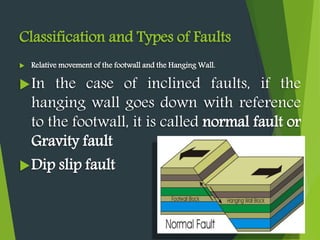Faults and folds
- 1. PETROLEUM GEOLOGY AND EXPLORATION Folds and Faults Compiled by: Hashir Ali Siddiqui D-17,PG-30
- 2. Folds: Folds are one of the most common geological structures found in rocks. When a set of horizontal layers are subjected to compressive forces, they bend either upward or downward. The bend noticed in rocks are called folds.
- 3. Folds
- 4. Classification and Types of Folds Anticline Fold When the beds are bent upwards, the resulting fold is called anticline. This fold is convex upwards.
- 5. Syncline Fold Syncline is just opposite to anticline in its nature, i.e. when the beds are bent downwards the resulting fold is called syncline. This fold is convex downwards.
- 6. Classification and Types of Folds Symmetrical and Asymmetrical Folds When the axial plane divides a fold into two equal halves in such a way that one half is the mirror image, then the fold is called as symmetrical fold. If the compressive forces responsible for folding are not of the same magnitude, asymmetrical folds are formed.
- 7. Symmetrical and Asymmetrical folds
- 8. Classification and Types of Folds Overturned Fold Usually, in simple folds, the limbs show the order of superposition. But when one of the limb is overturned, the order of superposition of beds in that limb will be in reverse order and such a fold is called an overturned fold.
- 10. Causes and Effects of Folding Most of the important folds, as already pointed out, are due to tectonic causes. But a few folds of a minor type are due to non-tectonic causes, Mainly, the compressive and shear type of tectonic forces are responsible for the folding phenomenon. Igneous intrusion of viscous magmas such as laccoliths and lopoliths also contribute to folding. Non-tectonic causes like landslides, creeping, differential compaction, isostatic setting and glaciations too are responsible for some folds. These are minor in terms of frequency of occurrence and magnitude.
- 11. Faults: Structurally, faults may be described as fractures along which relative displacement of adjacent blocks has taken place.
- 12. Faults
- 13. Foot Wall and Hanging Wall
- 14. Classification and Types of Faults Relative movement of the footwall and the Hanging Wall. In the case of inclined faults, if the hanging wall goes down with reference to the footwall, it is called normal fault or Gravity fault Dip slip fault
- 15. Classification and Types of Faults If the kind of displacement of the hanging wall is opposite to this, the fault is called Reverse faults or thrust fault.
- 16. Strike Slip Fault In strike slip faults,the sideways displacement occurs
- 17. Oblique Slip Fault While,in oblique slip faults both sideways and upward & downward displacement occurs.
- 18. Classification and Types of Faults Horst and Grabens When normal faults with mutually diverging or converging fault plane occurs, then a few wedge-shaped blocks called “horst” are displaced upwards and a few other called “grabens” are displaced downwards.
- 19. Causes of Faulting Faults may occur due to various causes, among them tectonic causes are responsible not only for most of the faults but also for faults of grater magnitude. It may be recollected that faults develop mainly due to shear and sliding failures resulting from tectonic forces. It is natural that compression and tensional forces be mutually interlinked because if in one part of the crust there is compression, in the adjacent part there will be tension. In addition to these main causes, sometimes, the formation of magmatic intrusions such as bysmaliths, may also contribute to faulting, though on a very small scale. Occasionally, local settlement under the influence of gravity may also cause minor faulting.




















